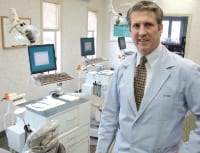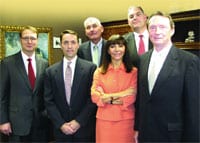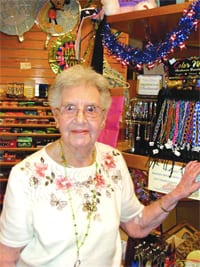Let’s Get Something Straight McKenna Orthodontics Has Helped Build a Century of Smiles
Technology has been radically altering the practice of orthodontics, from the use of space-age metals to computer-aided simulations for treatment, Dr. Stephen McKenna told the Healthcare News. And at his Chicopee practice, those changes have been tracked along the way since the very earliest days of this dental specialty.
Modern orthodontics originated around the turn of the 20th century, when Dr. Edward Angle, considered the father of the field, wrote the definitive manual on dental malocclusions, or crooked teeth, still in use today. His Angle School of Orthodontia, started in 1900 in St. Louis, was the first of its kind to focus on this specialty.
McKenna is the current family member at the helm of McKenna Orthodontics, a good contender for the oldest continuously operating orthodontic practice in the world. His grandfather, Dr. Paul McKenna, bought the practice in Springfield in 1918, and while the office has changed location, the ‘McKenna Ortho legacy,’ as it has become known, is a story of one family with unwavering generations involved in dentistry.
McKenna counts himself as the 13th orthodontist in this legacy of specialists. If one counts the numbers of both dentists and dental hygienists, that number increases even more.
But it wasn’t his grandfather who started the legacy. The family tree of dentistry begins around 1913, when Paul’s brother, Ernest, made $100 the summer just out of high school working as a bellhop on Lake Winnipesaukee. Upon his return to the family home in Boston, a chance encounter with a friend led him to follow his chum to dental school at Tufts University. “Yeah, I think I’ll go,” Ernest said casually, not knowing he was setting in motion the family legacy. The price of tuition? That $100 in his pocket.
Back at the McKenna homestead, mother Maggie had her hands full. She put the brakes on son George’s attempts to languish indefinitely in a series of different colleges, and, as a family biographer noted, she sent him packing to Tufts’ dental school at the end of a broomstick. Meanwhile, Paul McKenna decided that his career as a door-to-door salesman pitching soap for Chase and Sanborn wasn’t exactly the career path he’d hoped for, and he followed his brothers to Tufts late in the semester. Before the end of the year, Paul was well ahead of his fellow classmates.
As the boys graduated, World War I meant a change of plans for the newly-graduated dentists. Ernest ended up practicing in Boston, George ultimately set up practice in Providence, and Paul’s first commission was as an Army dentist assigned to a Massachusetts state sanitarium. Again, fate played a role for the McKennas.
At this post, Paul worked for Dr. A. LeRoy Johnson, a pioneering dentist specializing in the field of orthodontics. In time, Paul and his brothers decided to undergo the additional training necessary for this field, and upon graduating from the Dewey School of Orthodontics in New York, Paul rejoined Johnson at his practice in Springfield. Notably, when Johnson eventually sold the practice to McKenna, he went on to become the dean of Harvard’s dental school.
That office was located at 14 Chestnut St., across from the Quadrangle. It was there that Paul McKenna’s son, Paul Jr., took over his father’s operation upon becoming an orthodontist (a career also chosen by two of his four other children). When Chestnut Towers was built, the city took the property by eminent domain. But down the street, Baystate West had just been completed, and when he took his offices to the 17th floor there, Paul Jr. liked to joke that he was “the top orthodontist in New England.”
Braced for Change
Paul McKenna Jr. and his family settled in Longmeadow, but he maintained his office downtown for decades. When asked why he didn’t relocate to the suburbs, following mid-century America’s evolving consumer and residential trends, he would say that, while Longmeadow was a great place to raise a family, it was the “land of promise,” insofar as people would “promise to pay, but never would.”
Stephen McKenna said that, when he came to his father’s practice, both orthodontists understood that the suburban demographic still needed to be addressed, so the team opened an office in Feeding Hills.
“When new orthodontists would come into the area, they were opening up shop in the suburbs and dominating that population,” McKenna told HCN. “When I came in, he said the only place that wasn’t serviced just outside of Springfield was Agawam. So we opened an office there and took patients one day a week or so.”
But, he added, there wasn’t an orthodontist located within the city of Chicopee, either. Not wanting to miss out on the opportunity to branch out in such a large market, McKenna decided the time was right to finally make the shift from downtown Springfield.
“I heard that that there was someone who was looking at this city,” he said, “but I decided to go for it and set up shop here myself. I was the first in Agawam and the first in Chicopee. When we opened here, we found that people in Springfield were saying that they would rather drive here and park right out front, than have to navigate downtown.”
Straighten Up
While changes to the McKenna legacy came in the numbers of family members to enter the profession, Stephen said that high-tech developments have wrought the most notable changes of all.
“The first step in technology was some of the super metals that came out of NASA research,” he explained. “Instead of the old-fashioned stainless steel that we used to use, now they have nickel titanium and copper titanium wires that have an engineered shape memory.
“This engineered bend is pre-formed. Bend it, and run it under hot water,” he demonstrated as he tightly kinked the U-shaped wire, which slowly returned to its original shape.
“Instead of the wires that we used to wedge into the slots or glued-on braces,” he said, recalling the memories of laborious and sometimes painful steel wires involved in orthodontics of the prior generation, “we feed these new thin wires through, and the heat of your mouth forces them to return to their original shape. That is what makes the teeth level and align. Once I put it in, it will take about an hour to reach temperature and start to slowly work at the teeth.”
Anyone who had orthodontic work before the advent of these high-tech metals can easily understand the difference from the monthly orthodontic wire-tightening appointments that left the patient’s teeth and jaw more than slightly sore.
With the relative ease of installing this flexible wire, the time and frequency of subsequent service visits is greatly reduced, something McKenna said is responsible for reducing the price of orthodontics. “Where we once had people return every three to four weeks, now that time is pushed back to six to eight weeks.”
While the traditional method of attaching braces and wires to teeth has shifted to these new materials, the technique known as Invisalign has been something of a cultural revolution for the industry. No longer does an orthodontist need to permanently bond the braces to the teeth; rather, a series of computer-designed trays are fitted for the patient.
“Invisalign is changing orthodontics significantly,” McKenna said. “It opens up doors to people who wouldn’t use orthodontics otherwise. They don’t want the inconvenience or embarrassment of wearing braces.”
He explained how a polyvinyl mold is made of the patient’s teeth, and the resulting model is sent off to the Invisalign company. “They scan that in and make digital renderings of the teeth and projections for improvement,” he said, “and they then fabricate trays that fit into your mouth. What happens is that you put light pressure on the teeth, and, physiologically speaking, that pressure on the tooth socket and the ligaments there makes the tooth move.”
While Invisalign is an excellent solution for many clients, he stressed the limitations of the technique. It’s not for everyone, he explained, and it does require a commitment for the patient to meticulously wear the equipment in order to work. A product the company makes for teens has color-coded markers to denote how rigorously the patient has been wearing the Invisalign trays, and “if you don’t have the responsibility to keep up with it, that technique isn’t a good idea,” he said.
Picture Perfect Smile
With a bachelor’s degree in art before his dental training, McKenna said that he has a bit of a philosophical take on orthodontics. In working to enhance the lives of his patients, his approach involves a combination of art, healing, and science. “There’s more to orthodontics than following a recipe,” he noted.
“What we’re doing is trying to create beauty, and when teeth come together to make someone’s smile better, that to me is perfect. But you can’t do the same thing to every person. It doesn’t work that way. My job is to make the bite and mechanics perfect, and then get into the aesthetics after.”
Looking toward the future of the McKenna Ortho legacy, he said that the family will most likely continue to help people smile for another generation. Two of his three children are currently in college, both in pre-med programs. But it remains to be seen if they follow in their father’s footsteps.
“More importantly than anything else,” he said, “I’ve told them to find something they love doing. I genuinely love this field. If you love your work, you’ll never work a day in your life.”
Thinking back on his forefathers, McKenna said that he is proud to be the latest member of the family legacy. “But their foresight was incredible,” he added. “It isn’t lost on me that I’m standing on the shoulders of giants.”




Comments are closed.